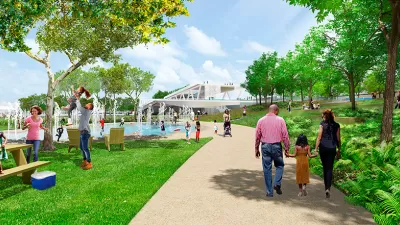From the beginning of the proposal for the new 11th Street Bridge between Anacostia and Capitol Hill, planners and designers have promised to prevent the displacement of residents living nearby the new amenities offered by the bridge and its park.
Shaun Courtney reports on the latest efforts to ease the effects of gentrification and displacement around the 11th Street Bridge project in the works to provide a pedestrian connection between Capitol Hill and Anacostia, across the Anacostia River.
Back in 2015, the project made news for its deliberate focus on equity and gentrification; now, with the project expected to be complete in 2019, we're seeing some of those ideas in action.
According to Courtney, the project’s director, Scott Kratz, is "focused on making sure residents on the Anacostia side lock in a chance to profit from rising property values before being priced out." More specifically, "Besides helping train residents for jobs building the bridge, [Kratz and his team are] working with City First Homes to establish a community land trust to permanently preserve affordable housing around it. They’ve also partnered with the nonprofit Manna to support homeownership opportunities through first-time-homebuyer clubs—24 members have moved into new homes so far."
In addition to those community development and social equity efforts on the periphery of the project, Courtney also lists the ways the design of the Bridge Park, created by the Office for Metropolitan Architecture (OMA) and the landscape-architecture firm Olin Studio, "is meant to encourage social and economic equality, too." To do so, the design calls for free spaces, a sloping "X" design to encourage interaction, a study of nearby urban farms, and art installations to invite more residents on the Anacostia side of the river.
FULL STORY: The 11th Street Bridge Park Isn’t Just a Vanity Project

Trump Administration Could Effectively End Housing Voucher Program
Federal officials are eyeing major cuts to the Section 8 program that helps millions of low-income households pay rent.

Planetizen Federal Action Tracker
A weekly monitor of how Trump’s orders and actions are impacting planners and planning in America.

Ken Jennings Launches Transit Web Series
The Jeopardy champ wants you to ride public transit.

New Jersey Lawsuit Targets Rent-Setting Algorithms
The state of New Jersey is taking legal action against landlords and companies that engage in what the state’s Attorney General alleges is illegal rent fixing.

Washington Legislature Passes Rent Increase Cap
A bill that caps rent increases at 7 percent plus inflation is headed to the governor’s desk.

From Planning to Action: How LA County Is Rethinking Climate Resilience
Chief Sustainability Officer Rita Kampalath outlines the County’s shift from planning to implementation in its climate resilience efforts, emphasizing cross-departmental coordination, updated recovery strategies, and the need for flexible funding.
Urban Design for Planners 1: Software Tools
This six-course series explores essential urban design concepts using open source software and equips planners with the tools they need to participate fully in the urban design process.
Planning for Universal Design
Learn the tools for implementing Universal Design in planning regulations.
Heyer Gruel & Associates PA
Ada County Highway District
Institute for Housing and Urban Development Studies (IHS)
City of Grandview
Harvard GSD Executive Education
Toledo-Lucas County Plan Commissions
Salt Lake City
NYU Wagner Graduate School of Public Service



























